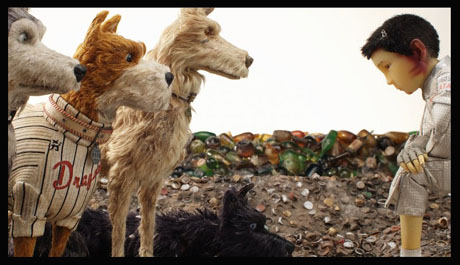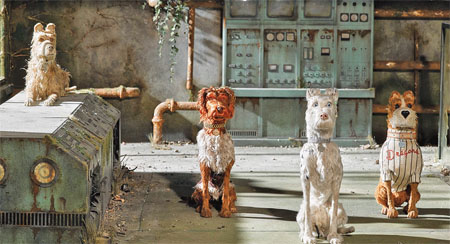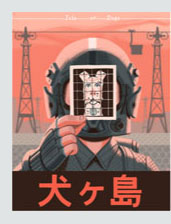
Wes Anderson’s Isle of Dogs is making a live New York appearance (Nov. 8 and 9), in the form of the gorgeous stop motion sets and the creatives who brought Megasaki’s canines and humans to life. This includes an appearance by puppet fabricator/modeler extraordinaire Andy Gent – who works regularly with two of today’s great stop-motion animators Tim Burton and Wes Anderson. Most recently, Gent was head of the puppet department for Anderson’s Isle of Dogs, which will be in the running for plenty of blue ribbons throughout the upcoming awards season. And some of the actual sets and puppets from the film will be on display for the public next month at Spoke Art/Parasol Projects (213 Bowery).
Jackson Murphy: 1,105 animatable puppets of dogs and humans. 2,000 background characters. That is just unbelievable. How in the world were you able to pull that off?
Andy Gent: Well it was quite a surprise to everybody. We set out at the beginning of the film with an estimated count of about 370. Then when we got to start sculpting, slowly but surely it was like, “Well it’d be good if we had a few more here and a few more there.” So we started to add the numbers up. And then we thought, “What clever ways could we do to make the crowds?” All these things were being thrown at us, and we expanded the crew a little bit for it all. We came-up with clever ways to make the 2,000 background characters and how we could replace heads and bodies and costumes to make it look like a cast of thousands. It was all by duplication and then cleverly re-dressing groups of crowds. And even using some semi low-relief ones in the background.

The amazing thing with Wes is that he was very adamant that this would be a crafted, in-camera film as much as possible. So we weren’t going to use CG – the minimum amount of digital manipulation. We set out with a palette and then cast out a load of characters for the backgrounds. The main characters on the film, obviously to shoot, it was such an ambitious project from the beginning. We’d have scales with “Fantastic Mr. Fox” and even “The Grand Budapest Hotel” where we made miniatures for various scenes. We sort of really excelled at this one and thought, “Well, let’s push that.”
So we got puppets the size of your fingernail for crazy, giant widescreen shots, and then we got large-scale, or hero-scale, ones, which are the expressive ones with mechanical heads and replacements. Not only the number of puppets, we also had to take on replacement faces, which on other projects I worked on, like “Coraline”, that would be digitally worked on and then printed out. But in classic Wes way, “Let’s make them by hand and sculpt them so everything’s really crafted.” He’s got the touch of an artist about everything.
We thought we’d have eight faces initially – to just about get us through all of the scene changes that we thought. So we did the eight faces thinking, like a Kabuki theater, you could get the next expression on another swift move. And then Wes was like, “Maybe we should have a little bit of talking.” And we went, “Oh. Talking is gonna take kinetics and lips, which we’ve done before.” By the time we finished it, I think we got 20,000 faces as well as the 1,105 puppets and the five scales.
So it was an incredible task, and we had to work very very hard to do it all. As a result, the crew was spectacular. We’ve never had so many sculptors together and mold makers. In every level of the film,we excelled in skills and the number of people to do it. And also in the time – we had to do it in a short window to get it done. All around an amazing effort from everybody on the team.

JM: That’s amazing. I saw the movie on opening day back in March – and it’s such a fast-paced film and so ambitious. You said it was a short timeline. How short was the timeline to get it all done? Was it as rapid of a process as watching the movie?
AG: Some of the characters require a long time to finesse and build. We didn’t skimp on any of that. For the lead, talking characters, we started a year before filming. But at the end of that year, we were into filming with some parts. I’ve been on it three years in total, but the actual main part of the crew was probably on it for two years. So in that period, we had to create all of that. We did initial passes where Wes said (one of the comments I love): “Well, just sculpt me some dogs.” They’re all mongrels and mutts. There was no hard core reference.
So we sculpted what we call a jack-o-matic style, which is a quick way… fast applying clay to a wire armature. A couple days – show me another sculpt. A couple days – show me another sculpt. We were sketching in clay (electric paste) to show different options. And he’d go “I like this. I like a bit of that.” So we generated characters from this quick sketch system. And while we were doing that, we were working with Felicie Haymoz, who’s the Swiss character designer, who’s now in New York. She was working with Wes and Paul Harrod on the costume and character designs. And then they would give human designs, and again we would do quick sculpts based on those.
We sculpted as fast we could. 12 sculptors working six days a week trying to get all this stuff done. And then Wes would pick from the three-dimensional form. And at the same time we were working with the costume designers collecting materials – thousands of sheets and cloths. Wes fascinated by the look and materials – that’s a very big interest for him. So all of this was happening at the same time – this electric pace. And once we got all that, then it sort of slows down into the pace of making the puppets. Most of them were 2-3 months each on the big characters in their hero forms. Some of them took longer. We were working on Kobayashi’s jacket for three months to get the perfect shape of a 1950s Italian white silk suit in hero scale and again in half that scale with the most incredible seems – and yet be able to animate on their own. So all of these things were happening layer on layer, one on top of each other, to try and save time.
JM: All of those details have certainly paid off. You mentioned also working with Wes on “The Grand Budapest Hotel” and “Fantastic Mr. Fox”, which I think is one of the Top 5 best animated movies of this century. I absolutely love that film. People have written books about Wes Anderson – they’ve tried to get inside his mind. Have you now gotten into the mind of Wes Anderson and figured it out?
AG: I think working with Wes more often, you get a little bit more of the confidence to suggest and talk about things. But Wes is very difficult to double guess. The moment you think you can double guess, you’ll probably be surprised that it’s not what you thought. He pushes and pushes and pushes. You can suggest something, and I think he gets confident with people – he likes to come back with people. He likes familiarity. And I think it’s a trust thing. He trusts people he works with. And once you build up that trust and that faith, then you can show more and more things and everybody gets more confident. But the amazing thing with Wes is that he’ll go, “Well, you might say that’s really difficult to do, but let’s try it and see where it takes us.” And he will always push us into new, interesting and quirky ways. And he never stops amazing us with that.

JM: You said you’ve worked on “Coraline”. You’ve also worked on a couple of Tim Burton stop-motion movies – “Corpse Bride” and “Frankenweenie”. Prior to this year, since 2005, every major stop-motion animated film that has been released has been nominated for the Best Animated Feature Academy Award. All 12 of them. How else have you noticed the appreciation for this art form over years and years of working on these movies.
AG: When I did “Corpse Bride” with Tim, I remember thinking, “Wow. I managed to work on a stop-motion feature film. How happy am I! This will be the last one that’s ever made.” (laughs) We started with 35mm cameras. We were all familiar with that way of working. And then in a short period of time, there was an explosion of technology… to digital cameras, that ability, that ease to make it, to get in more, to change the medium, to not be restricted by some of the old technology.
Now we’re in a world where… I’ve just done a course for the weekend with kids to show them how to design and build and animate puppets. And they’re already very savvy with making LEGO movies and animating on mobile phones. This explosion of easy technology: there’s so much familiarity people have with it an early age. It was difficult for me. I had to go through a university and get into that film, but now it’s so much easier. You’ve got people so much younger that have already made two or three things. It’s changed the dynamic of the world where people think, “Oh. I can animate things in my living room with my mobile phone.” So that ability to tell stories and then to go, “Well actually I can make a bigger thing” has gotten easier and easier.
The whole aesthetic of stop-motion, which an amazing and very unique thing, has become much more manageable and easy for more people. So all of that creativity – all those crazy ideas and thoughts – are not restricted by technology. It’s made it very accessible. As well as these amazing directors like Wes and Tim – keeping it alive. I think Wes has reinvented it from many of the other ways of working. He gives it this great look that he’s made his own.
JM: Every film keeps raising the bar when it comes to this form of animation, and I love that you’re teaching the kids. So some of the sets will be at Parasol Projects in NYC (on 213 Bowery) from Nov. 8-11. They are “King’s Family Kitchen” and “Spot’s Home”. How do you feel about people now being able to pick out every little detail that you and your team have created?
 AG: Oh, I’m delighted! The movie is a very special, spectacular feast for the eyes and the mind. But when you actually see the sets for yourself, they’re like jewelry. They’re these little moments that fly by in the film. But when you can stand in front of them and see all the lavish details that have gone in by the art department, set builders, painters, puppet makers, it is a completely different treat. We had a huge exhibition in London. It was only on for a few days, and something like 58,000 people came to see it. To be able to have a little look at these things and see the things that… when you can pause in front of them, it’s a brief moment in time, but you’ll get to see so much detail and so much craft. It’s amazing.
AG: Oh, I’m delighted! The movie is a very special, spectacular feast for the eyes and the mind. But when you actually see the sets for yourself, they’re like jewelry. They’re these little moments that fly by in the film. But when you can stand in front of them and see all the lavish details that have gone in by the art department, set builders, painters, puppet makers, it is a completely different treat. We had a huge exhibition in London. It was only on for a few days, and something like 58,000 people came to see it. To be able to have a little look at these things and see the things that… when you can pause in front of them, it’s a brief moment in time, but you’ll get to see so much detail and so much craft. It’s amazing.
JM: I hope everybody checks it out. I will be down there to see it that weekend. Now, I heard you have a chocolate lab. What’s your dog’s name?
AG: Charlie! And he’s standing next to me now. In fact, he’s wagging his tail because I said his name.
JM: Hi, Charlie!
AG: He was with us for the whole film. In fact, he started with us on “Fantastic Mr. Fox” as a puppy. He’s been with us on all of the films. And he was moved, stretched, walked, sat, manipulated in every way he could be as reference for the film. So he’s as part of the film as I am.
JM: Wow. So he was… literal inspiration for you guys on set.
AG: Oh, yeah.
JM: And what does he think of the movie? Is he happy with how it turned out?
AG: Well, he’s fascinated by the characters. He sees some of the puppets in the workshop, and he always gives them a little sniff and a look. So yeah, he’s very happy with it.
- INTERVIEW: Jeff Fowler On “Knuckles” And “Sonic 3” - April 22, 2024
- INTERVIEW: “Inside Out 2” Director And Producer On Pixar Sequel - April 16, 2024
- INTERVIEW: “Puffin Rock And The New Friends” And 25 Years Of Cartoon Saloon - April 10, 2024


 October 29th, 2018
October 29th, 2018  Jackson Murphy
Jackson Murphy  Posted in
Posted in 






